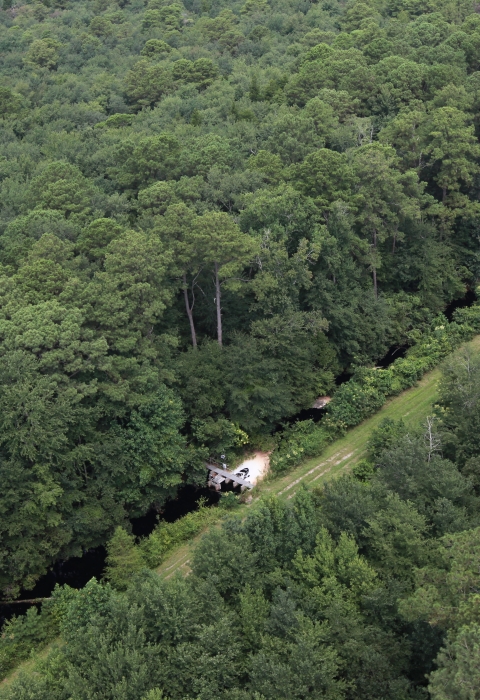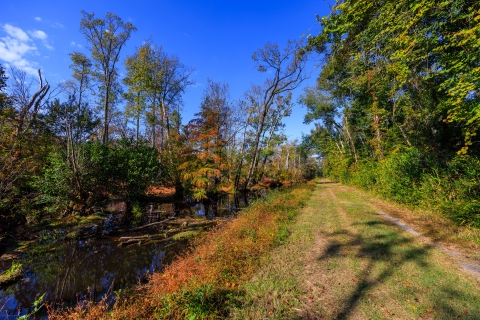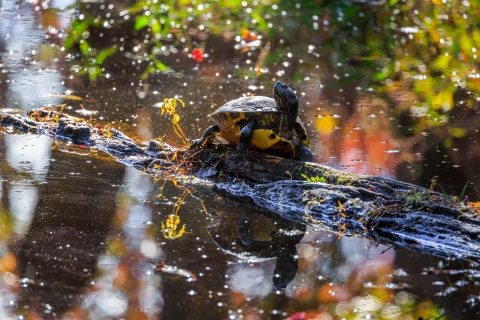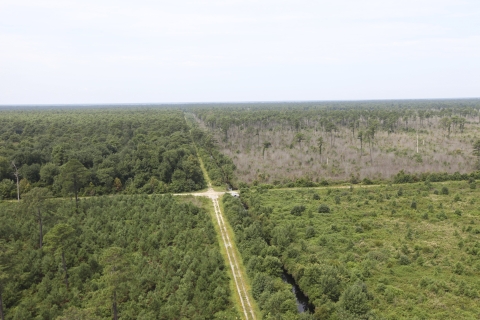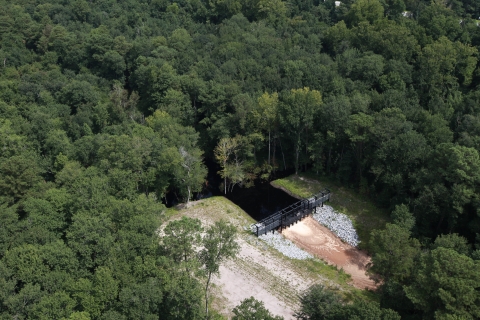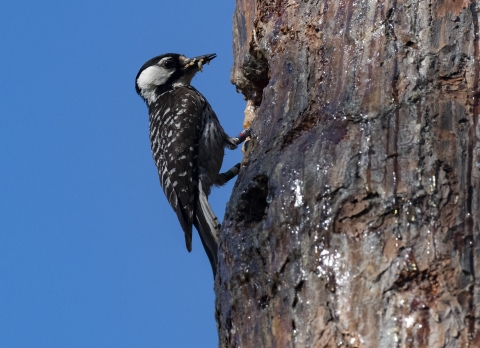The refuge is still. It’s a quiet morning, except for the hum of insects and tiptoe of creatures through dense undergrowth. The air is heavy with moisture, and dew sticks to the leaves. Birds whistle to greet the day.
Suddenly, the chorus of birdsong is interrupted by the grunts of an excavator rolling along the gravel road through the forest of red maple and gum trees. A cloud of dust fills the air. Shaken awake, a river otter pokes its head out of the thicket. An eastern painted turtle flops into the adjacent water-filled ditch and darts away.
But this isn’t a case of paving paradise — rather, it's part of a plan to create paradise anew in Great Dismal Swamp National Wildlife Refuge.
In response to natural disasters, the U.S. Fish and Wildlife Service has been constructing and repairing water control structures throughout the refuge to restore the swamp’s natural hydrology, regenerate historical habitat and support a landscape that will be more resilient to the effects of climate change climate change
Climate change includes both global warming driven by human-induced emissions of greenhouse gases and the resulting large-scale shifts in weather patterns. Though there have been previous periods of climatic change, since the mid-20th century humans have had an unprecedented impact on Earth's climate system and caused change on a global scale.
Learn more about climate change .
The excavator operator is part of a construction team that’s installing water control structures to plug man-made ditches that have allowed water to leak from the swamp for more than 200 years. Dug to make the land suitable for logging and farming, the ditches drained most of the swamp — once covering more than one million acres — and severely altered the ecosystem.
With the water control structures in place, the swamp will hold water once again and provide habitat for native plants and animals that lived there long before humans changed the hydrology.
"Water is the lifeblood of the swamp. To support the vegetative communities, the diversity of the habitats, to support the diversity of the wildlife, we need water," said Chris Lowie, refuge manager at Great Dismal Swamp National Wildlife Refuge.
A refuge long before
Admittedly, turning a “dismal swamp” into a “paradise” might be subjective, but for many plants and animals — and humans — the site has been exactly what they needed for thousands of years, ages before it became a national wildlife refuge national wildlife refuge
A national wildlife refuge is typically a contiguous area of land and water managed by the U.S. Fish and Wildlife Service for the conservation and, where appropriate, restoration of fish, wildlife and plant resources and their habitats for the benefit of present and future generations of Americans.
Learn more about national wildlife refuge .
The Nansemond Indian Nation has long used areas of the swamp for hunting, foraging and agriculture. When colonists forced them from their villages in the 1600s, many of the Nansemond people moved deeper into the swamp. The wildness of the landscape protected them from outsiders — not many colonists were daring enough to venture into the thick, boggy swamp.
Eventually others in search of refuge, including freedom seekers, had similar ideas of living and hiding in the inhospitable, nearly uninhabitable swamp. It was isolated, humid, thickly vegetated, buggy and the perfect habitat for venomous snakes. Regardless of the challenges, people who had escaped slavery, known as Maroons, formed communities on small islands throughout the swamp, where people lived freer lives for generations.
Draining paradise
Similarly, plants and wildlife flourished amongst the murky waters, with diverse forests of bald cypress, Atlantic white cedar, pond pine, switch cane and black gum.
But in the 1700s, George Washington and other investors developed a plan to drain the swamp. With its abundance of trees and rich soil, they saw an opportunity for logging and agriculture. In 1763, the group founded the Dismal Swamp Company with a mission of “draining Improving and Saving the Land.” Using enslaved people for labor, they began a project to dig canal-like ditches throughout the swamp to allow water to slowly leak out.
By the time the national wildlife refuge was established in 1974, there was a 150-mile network of ditches throughout Great Dismal Swamp, draining the water from the swamp’s peat soils and dismantling the balance of the ecosystem.
Dangerously dry
In 2011, a lightning bolt touched down in Great Dismal Swamp, igniting a fire that sizzled for 111 days. The Lateral West Fire burned through 6,500 acres of the refuge and deep into the peat. Even a foot of rain, dumped by Hurricane Irene, couldn’t put it out.
Nearly a year later, Hurricane Sandy blasted through the area and drenched everything in its path. Water levels rose and caused devastating flooding in communities around the swamp.
Fire and flooding may sound like natural disasters on opposite ends of the spectrum, but they both pointed to the same issue at the refuge: dry peat.
Peatlands are formed by squishy layers of partially decomposed organic material that’s preserved by groundwater moisture, which prevents old plants and materials from fully decaying. They hold the past — one meter of peat could contain thousands of years of plant material — and store an incredible amount of carbon. Peatlands, like Great Dismal Swamp, cover just 3% of the earth’s surface but contain twice as much carbon as the world’s forests.
But when lit, dry peat can fuel a smoldering megafire that is extremely difficult to extinguish and emits thousands of years of stored carbon into the atmosphere. The Lateral West Fire released more than a million tons of carbon.
Peat is like a sponge – it easily absorbs more liquid when it’s wet but repels water when it’s dry. In flood scenarios, hydrated peatlands will soak up much larger volumes of flood waters compared to peat that has dried out.
The impacts from the Lateral West Fire and Hurricane Sandy were signs that we needed to focus on rewetting the swamp. As natural disasters caused by climate change become more frequent, returning the swamp to its natural hydrology is a step towards resilience.
Soaking the swamp
Rewetting the swamp was long overdue.
"There are letters written back and forth between the USGS and the U.S. Fish and Wildlife Service in the ‘70s that discuss how to get this swamp rewetting project done, and there's a report by a forester working in the Dismal Swamp in the ‘20s, talking about the need to slow drainage in these ditches," said Fred Wurster, Service geomorphologist.
But slowing the drainage was easier said than done. More complicated than plugging a single bathtub drain, the swamp was like a colander, with multiple holes releasing water through the 150 miles of ditches. We needed a plug – or in this case, an adjustable dam that allows us to control water levels – for every hole in that colander.
In the 50 years since the refuge was established, we’ve placed 75 water control structures throughout the network of ditches to effectively hold water — 46 were installed in the last decade.
Each structure structure
Something temporarily or permanently constructed, built, or placed; and constructed of natural or manufactured parts including, but not limited to, a building, shed, cabin, porch, bridge, walkway, stair steps, sign, landing, platform, dock, rack, fence, telecommunication device, antennae, fish cleaning table, satellite dish/mount, or well head.
Learn more about structure was placed by an experienced construction crew, but the project wasn’t without its challenges.
“It’s thick with vegetation, and the soils can turn to soup pretty quickly,” described David Byrd, state coordinator for our Partners for Fish and Wildlife Program in Virginia and project manager for a portion of the water control structure installations. “And even once the water drains down after a storm, the soils are really challenging because they don’t hold equipment easily. You can sink an excavator or dump truck in the soil.”
The installation process for each water control structure takes at least a few weeks, so the project spanned years.
In the fall of 2022, the last of the significant restoration work was complete. Now, hydrologists can strategically adjust the flow and direction of water to raise it in areas of the swamp where it was historically higher.
Already they’re seeing a difference.
“We have slowly raised water levels,” said Karen Balentine, hydrologist at Great Dismal Swamp National Wildlife Refuge. She’s been monitoring the swamp’s hydrology for nearly a decade and has noticed an upward trend.
With these control capabilities, ideally the swamp’s hydrology will one day more closely resemble that of its past.
A tool for habitats
As the swamp dried up over centuries, the ecosystem changed as well. Wetland-loving trees like Atlantic white cedar, bald cypress and pond pine were pushed out by red maple and sweet gum. The once-diverse forest community shifted to a more homogenized landscape.
"Before we did all this work, the swamp was a forest adapted to this new reality of drainage,” Wurster said. “What we're trying to do is create the conditions that will help push it back to what it was before it was drained.”
With water-control capabilities in the refuge, we can create an environment more suitable for historical species, like pond pine, to thrive once more.
"Water, just like fire, is a tool to manage our habitats,” Lowie said.
With this tool in our belt, now we can look towards the next steps of habitat restoration. We’ll help form a healthy forest by thinning and making room for new growth in the pond pine pocosin — a type of peatland — habitat. Wildlife will benefit from this, too.
Hope is the thing with feathers
The red-cockaded woodpecker, a bird that inhabited the historical swamp, vanished due to the loss of pond pine habitat. It’s currently listed as endangered under the Endangered Species Act.
Since 2015, we’ve tried to reintroduce the woodpecker to the swamp by translocating groups of them from nearby populations. There’s now a small population at the site, but we have a more well-rounded plan going forward.
“We’re going to enhance the habitat, and hopefully that’ll help them more than translocation,” Lowie said. “The habitat won’t support the woodpecker population unless we do the habitat work.”
Now, with the water control structures, we have a shot at providing the woodpecker’s habitat once again.
Across the refuge, other native species will also benefit from the changes in the swamp’s hydrology — creating a rebalanced landscape, just like Mother Nature intended.
Reaching its potential
Of course, the swamp will never be exactly as it was prior to the ditches being dug, but with the water control structures in place, we can get closer. As the peat soaks up water, it will begin to rebuild the character of the landscape; create opportunities for plants, wildlife and even visitors to find refuge; and set the stage for biodiverse communities to develop again.
And to combat the impacts of climate change, like flooding and wildfires, rewetting the peat is a no- brainer.
“It’s a no-regrets, nature-based solution to a number of pressing challenges that we're dealing with here in our region and across the globe,” said Eric Soderholm, coastal wetlands restoration lead for The Nature Conservancy in North Carolina — one of the project partners.
George Washington may not have understood the impacts of his actions when he began to drain the swamp. As the song goes: “You don’t know what you’ve got ‘til it’s gone.” Though we can't change history, we can at least create a better future, so that Great Dismal Swamp can once again be paradise to those who need it most.
